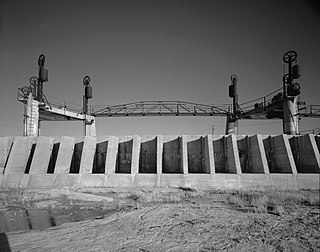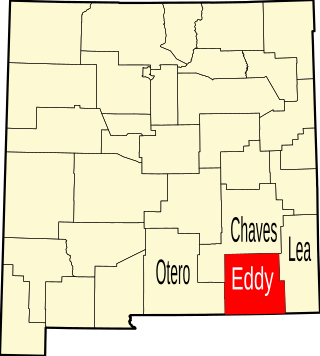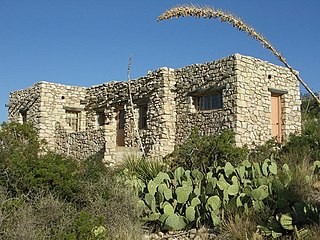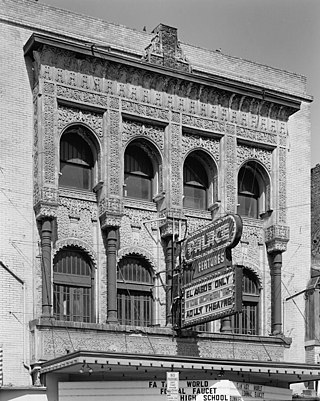
Carlsbad is a city in and the county seat of Eddy County, New Mexico, United States. As of the 2020 census, the city population was 32,238. Carlsbad is centered at the intersection of U.S. Routes 62/180 and 285, and is the principal city of the Carlsbad-Artesia Micropolitan Statistical Area, which has a total population of 55,435. Located in the southeastern part of New Mexico, Carlsbad straddles the Pecos River and sits at the eastern edge of the Guadalupe Mountains.

The Plaza Hotel, formerly the Hilton Hotel, is a landmark skyscraper located at 106 Mills Avenue in El Paso, Texas, USA.

Sunset Heights is a historic area in El Paso, Texas; which has existed since the latter part of the 1890s. Many wealthy residents have had their houses and mansions built on this hill. Although some buildings have been renovated to their former glory, many have been neglected and have deteriorated. An organization, the Sunset Heights Improvement Association helps neighbors on a fixed income to manage home maintenance and also sponsors an annual tour.

El Paso High School is the oldest operating high school in El Paso, Texas, and is part of the El Paso Independent School District. It serves the west-central section of the city, roughly south and west of the Franklin Mountains and north of Interstate 10 to the vicinity of Executive Center Boulevard. It is fed by Wiggs Middle School, into which the three elementary schools in its feeder pattern, Lamar, Mesita, and Vilas, graduate.

Magoffin Home is located in El Paso, Texas. It was placed on the National Register of Historic Places in 1971. The surrounding area was declared the Magoffin Historic District on February 19, 1985. The home is now known as the Magoffin Home State Historic Site under the authority of the Texas Historical Commission.

The original Franciscan mission, Nuestra Señora de la Concepción del Socorro, was founded in 1682 by the Franciscan order, to serve displaced Spanish families, American Indians from New Mexico, who fled the central New Mexico region during the Pueblo Revolt. The present Socorro Mission was constructed around 1839 to replace an earlier 18th-century mission destroyed in 1829 by flooding of the Rio Grande. The mission, constructed of adobe surfaced with stucco, is particularly notable for its interior. The finely painted and decorated beams, or vigas, are from the 18th-century mission and were reused when the present church was constructed. The massing, details and use of decorative elements of the Socorro Mission show strong relationships to the building traditions of 17th-century Spanish New Mexico.

The Carlsbad Irrigation District, also known as Carlsbad Reclamation Project or Irrigation system of the Pecos Irrigation and Improvement Company, is a major early water reclamation project located near Carlsbad in southeastern New Mexico. Begun in the 1880s, it is now managed by the United States Bureau of Reclamation, and provides irrigation water to a large area around Carlsbad, diverted from the Pecos River and the Black River. The late 19th and early 20th-century elements of the project were designated a National Historic Landmark District in 1964.

This is a list of the National Register of Historic Places listings in Eddy County, New Mexico.

The Ysleta Mission, located in the Ysleta del Sur Pueblo within the municipality of El Paso, Texas, is recognized as the oldest continuously operated parish in the State of Texas. The Ysleta community is also recognized as the oldest in Texas and claims to have the oldest continuously cultivated plot of land in the United States.

This is a list of the National Register of Historic Places listings in El Paso County, Texas.

The Caverns Historic District comprises the central developed area of Carlsbad Caverns National Park. The complex was built between the early 1920s and 1942, initially in Pueblo Revival style, and later in New Mexico Territorial Revival style in the area around the natural entrance to Carlsbad Caverns. The earlier structures are built of local limestone, the later buildings in adobe. Thirteen buildings in the district are considered contributing structures. Buildings built between 1940 and 1942 were constructed with labor provided by the Civilian Conservation Corps.

Cornudas is an unincorporated community in Hudspeth County, Texas, United States. Cornudas is located near the intersection of Ranch to Market Road 2317 and the concurrent U.S. Highways 62 and 180, 42 miles (68 km) northwest of the county seat, Sierra Blanca. Cornudas was located in 1929 strategically on the most direct route between El Paso, Texas and Carlsbad, New Mexico as a natural rest and resupply station. It was directly or indirectly named for the Cornudas Mountains that can be seen behind the Cornudas Cafe.

The Alhambra Theatre, also known as the Palace Theatre, is a building in El Paso, Texas. Opened on August 1, 1914, the building was designed by architect Henry C. Trost in the Spanish Colonial Revival style with a Moorish theme, preceding spread of the Moorish Revival style of the 1920s. The building cost $150,000. It was prepared to serve either as a playhouse for live theater or as a movie house, and included a large organ to be played with silent movies of the day.

The Presidio Chapel of San Elizario was built in 1877 at the same place where an earlier Mexican chapel stood. The building is located in the central square of San Elizario, 17.5 miles south-southeast of El Paso. It was listed on the National Register of Historic Places in 1972. It is an example of the Spanish Colonial style.

The Woman's Club of El Paso was founded in the late nineteenth century, and during that time was the only woman's organization in El Paso, Texas. The Woman's Club also allowed women in El Paso to become involved in community service and activism. The building which is the home for the club is located on 1400 N. Mesa Drive, and was erected in 1916. The club, now a non-profit organization, traces its official origins back to 1894, and continues to provide an "educational and cultural center for its members." The building is registered in the National Register of Historic Places.

The Toltec Club is a building located in downtown El Paso, Texas. The building was added to the National Register of Historic Places in 1979.

The Abdou Building is a historic seven-story building in El Paso, Texas. It was built for the Rio Grande Valley Bank in 1910, and designed by Trost & Trost. In 1925, it was renamed the Abdou Building after its new owner, Sam Abdou, who purchased it for $150,000. The same year, the American Trust and Saving Bank leased the building; one of its directors, Charles Klink was Abdou's stepson. By 1930, the El Paso Bank and Leavell & Sherman both had offices in the building. It has been listed on the National Register of Historic Places since September 24, 1980.

The First Mortgage Company Building is a historic fifteen-story building in El Paso, Texas. It was built for the First Mortgage Company in 1921, at a cost of $411,000. El Paso was going through a construction boom at the time, and it was the largest structure with the El Paso Scottish Rite Temple. It has been listed on the National Register of Historic Places since June 13, 1978.

The State National Bank is a historic building in El Paso, Texas. It was built in 1921 for the State National Bank, El Paso's oldest bank founded four decades earlier. It was built on the site of a former building for the same bank completed in 1881, which was El Paso's "first real building." The 1921 building was designed by Trost & Trost, and its construction cost $165,000. With "the latest technological developments", it cost $250,000. The interior was a single lofty room with roof supported by steel girders that eliminated need for interior columns. The bank moved into the building in January 1922. It was expanded by renting adjacent property 10 years later, which was annexed permanently in 1942. It was further expanded to the south in 1948.

J. J. Newberry Company is a historic five-story building in El Paso, Texas. It was built by the J. Calisher Realty Company in 1911, and it was known as Calisher's. The Calisher company was a store first opened in El Paso in 1881. Early tenants included the YMCA and the Border National Bank. It was later renamed for the J.J. Newberry, a five and dime store chain. The building was designed in the Chicago School architectural style by Trost & Trost. It has been listed on the National Register of Historic Places since September 24, 1980.





















